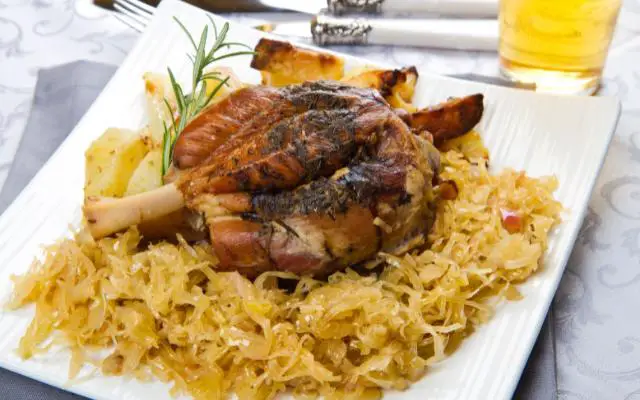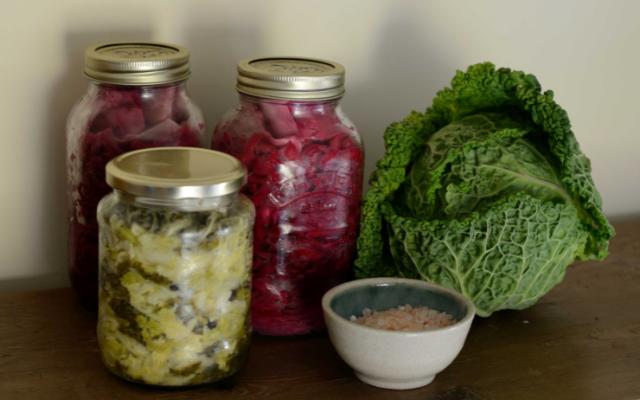This tart and tangy fermented cabbage dish has a long and storied history and has long been a favorite part of Bavarian Cuisine and a staple part of the diet of many Müncheners.
But Who Invented Sauerkraut and Where Did it Originate?
Well in this article, we’ll explore the Sauerkraut Origin by looking at evidence of its early beginnings, its spread across Europe, and its eventual transportation to the Americas.
So if you love sauerkraut and are interested in an overview tracing this humble preserved food from its distant roots to its global reach, then read on!
What is Sauerkraut?
Sauerkraut is a tart, crisp, shredded cabbage dish that has been fermented by lactic acid bacteria.
To make sauerkraut, finely sliced green or white cabbage is layered with salt and left to ferment, which allows beneficial bacteria to convert the natural sugars in the cabbage into lactic acid.
This process not only gives sauerkraut its distinctive sour flavor, but also preserves the cabbage for extended storage.
The fermentation process results in a tangy, crunchy, salty condiment or side dish that provides probiotics, vitamins, and antioxidants.
The finished product can have a range of textures from soft to firm, depending on fermentation time.
While German in origin, sauerkraut is now popular worldwide, often served alongside sausage or pork dishes such as Schweinshaxe, or used as a condiment in sandwiches.

Who Invented Sauerkraut?
History tells us that it was the Chinese that invented sauerkraut and that it was not a culinary invention of one single person.
The origins can absolutely be traced back to Chinese workers involved in the construction of the Great Wall of China over 2000 years ago.
At that time the Chinese were known for their specialty of fermented cabbage in rice wine. But apart from just cabbage they were known to use this process with a number of different vegetables also as they needed “long-lfe” products to see them through the winter months.
The concoction was later introduced to Europe, particularly Germany, where it became popular and was fermented using salt instead of rice wine. As a staple food, it was primarily popularized mainly by the poorer farm workers throughout Germania.
Many authoritative outlets have backed up this fact including the New York Times, GermanFoods.org, and Science Direct.
Bet You Didn’t Know This About Sauerkraut
Whilst the bill never really became law, the premise was that Sauerkraut would become “liberty cabbage”, Hamburger would become “liberty steaks”, and even German Measles was to become “liberty measles”.
What Does Sauerkraut Mean? What Is The Translation?
In German, Sauerkraut literally translates to “Sour Cabbage”.
In Chinese, dating as far back as the 7th century BC this fermented vegetable staple was known as Suan cai which translates to “Sour Vegetable” rather than sour cabbage. This is not to be confused with the Chinese Pào cài which is pickled cabbage.

The Sauerkraut Origin Historical Timeline
Ancient China (around 2,000 years ago)
Event: First Mentions of Fermented Cabbage
Description: During the construction of the Great Wall of China, laborers consumed fermented cabbage preserved in rice wine, believed to be an early form of sauerkraut.
Migration to Europe (1,000 – 1,200 AD)
Event: Introduction to the West
Description: As trade routes expanded and cultures intermingled, the practice of fermenting cabbage made its way to Europe, particularly in Eastern European and Germanic regions.
16th Century
Event: Widespread Use in Europe
Description: Sauerkraut became a staple in European diets, especially among sailors, due to its vitamin C content which helped prevent scurvy during long sea voyages.
18th – 19th Century
Event: Popularity in the Americas
Description: European immigrants, especially the Germans, brought sauerkraut to the Americas. It became integrated into local cuisines, leading to dishes like the Reuben sandwich.
World War 1 Anti-German Sentiment Period
Event: Proposed Congressional bill to ban German words and references in America
Description: Sauerkraut was to ridiculously be renamed “liberty cabbage”.
Modern Day
Event: Global Recognition and Health Trend
Description: With the rise of health and wellness trends, sauerkraut is recognized not just as a tasty food but also for its probiotic benefits, leading to a resurgence in its popularity worldwide.
How is Sauerkraut Made?
In both traditional and modern methods, the key is the fermentation process, which preserves the cabbage and gives sauerkraut its distinctive tangy taste. However, the tools, ingredients, and flavors have evolved over time, reflecting changing tastes and technological advancements.
Traditional Chinese Method vs. Modern Alternatives
Chinese Method of Making Sauerkraut:
In ancient China, the precursor to what we know as sauerkraut was made using a different technique to today’s version.
Cabbage, often mixed with other vegetables, was fermented in rice wine or other fermenting agents. This method not only preserved the cabbage but also imparted a unique flavor profile distinct from the sauerkraut we’re familiar with today.
The fermentation took place in earthenware pots, which were buried underground to maintain a consistent temperature, aiding the fermentation process.
Modern Alternative Method of making Sauerkraut:
The most common modern method involves finely shredding cabbage and adding salt. The salt draws out the cabbage’s natural juices, creating a brine in which the cabbage ferments.
Modern variations might include additional ingredients like caraway seeds, juniper berries, or other vegetables for flavor.
Additionally, with the advent of technology, fermentation can be controlled more precisely using specialized fermentation vessels with airlocks. This ensures an anaerobic environment, promoting the growth of beneficial bacteria while preventing harmful ones.
There’s also a trend of experimenting with flavors, leading to gourmet variations of sauerkraut infused with ingredients like apple, beetroot, or ginger and many of these variations can now be found on menus throughout Munich.

Health Benefits of Sauerkraut
Sauerkraut is more than just a delightful side dish; it’s a proven health powerhouse and plenty of experts claim it as a superfood including those who administer aarp.org, healthline.com and nutritiouslife.com.
Incorporating sauerkraut into meals not only elevates flavor but also brings a myriad of health benefits, making it a worthy addition to diverse diets.
Nutritional Value of Sauerkraut:
Rich in essential vitamins, especially Vitamin C for immune support and Vitamin K2 for bone health. Its fermentation process enhances the bioavailability of these nutrients, ensuring better absorption.
Probiotic Benefits:
The fermentation of sauerkraut fosters the growth of beneficial bacteria. These probiotics are pivotal for optimal gut health, aiding digestion and potentially reducing issues like bloating or constipation.
Dietary Importance:
Sauerkraut finds its place in various health-centric diets. From Paleo to Whole30, its natural fermentation and absence of additives make it a preferred choice.
Additionally, for vegans and vegetarians, it’s a valuable source of B vitamins.

Sauerkraut and Our Experience at Absolute Munich
We’ve always had a penchant for trying diverse cuisines here at Absolute Munich, but it wasn’t until 1994, on our first visit to Germany, that we stumbled upon sauerkraut. I can assure you at that time we didn’t order it, it just came as a side!
However, the tangy delight caught our palate, and we were instantly intrigued. Since then, sauerkraut has been a side dish that we’ve not only gotten used to but have come to enjoy very much as part of our diet and we probably have it now way more than we can actually remember.
We hope you enjoyed learning more about the sauerkraut Origin and are tempted to try their delectable fare yourself – perhaps at home – or perhaps on a trip here to Munich!
Cheers everyone, Happy travels, and thanks for reading.
